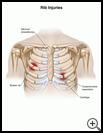
Rib Injury
________________________________________________________________________
KEY POINTS
- A rib injury is a bruise, strain, break, separation, or irritation of one or more of the ribs in your chest. It can also be an injury to the tissue called cartilage that attaches the top 10 ribs to the breastbone.
- Your healthcare provider may prescribe pain medicine and breathing exercises while the ribs heal to prevent lung problems.
- It may also help to rest and put an ice pack, gel pack, or package of frozen vegetables wrapped in a cloth on the injured ribs a few times a day.
________________________________________________________________________
What is a rib injury?
A rib injury is a bruise, strain, break, separation, or irritation of one or more of the ribs in your chest. It can also be an injury to the tissue called cartilage that attaches the top 10 ribs to the breastbone.
What is the cause?
A fall or direct blow to the chest may bruise, strain, or break the ribs or injure the rib cartilage. Breaks usually happen in the outer curved part of the rib cage.
When a rib tears away from the cartilage, the injury is called a costochondral separation. It may result from a blow to the ribs, a fall, or when your child lands hard on their feet. It might even be caused by forceful coughing or sneezing.
Irritation of a rib is called costochondritis. It may be caused by an infection or repeated coughing, or by overuse, like from rowing or heavy lifting. Sometimes the cause is not known.
What are the symptoms?
A rib injury causes pain and swelling in the ribs. Your child may have pain when he or she breathes, moves, laughs, or coughs.
Contact the healthcare provider right away if your child coughs up blood, has a fever, or feels short of breath.
How is it diagnosed?
Your child’s healthcare provider will ask about your child’s symptoms and medical history. Your provider will examine your child’s chest and listen to the lungs. Tests may include X-rays or other scans.
How is it treated?
Rib injuries can be painful and make it hard to cough or take a deep breath. Your healthcare provider may prescribe pain medicine or injections (shots) to block pain.
Your child may need to do breathing exercises while healing to prevent lung problems.
Rib injuries usually heal without surgery. Bruised ribs or a costochondral separation usually take 3 to 4 weeks to heal. Broken ribs take 6 to 8 weeks to heal.
How can I take care of my child?
To relieve pain and help the injury heal:
- Make sure your child gets plenty of rest.
- Put an ice pack, gel pack, or package of frozen vegetables wrapped in a cloth on the injured ribs every 3 to 4 hours for up to 20 minutes at a time.
- Give your child nonprescription pain medicine, such as acetaminophen, ibuprofen, or naproxen. Read the label carefully and give your child the correct dose as directed.
- Nonsteroidal anti-inflammatory medicines (NSAIDs), such as ibuprofen, naproxen, and aspirin, may cause stomach bleeding and other problems. Check with the healthcare provider before you give any medicine that contains aspirin or salicylates to a child or teen. This includes medicines like baby aspirin, some cold medicines, and Pepto-Bismol. Children and teens who take aspirin are at risk for a serious illness called Reye’s syndrome.
- Acetaminophen may cause liver damage or other problems. Do not give more doses than directed. To make sure you don’t give your child too much, check other medicines your child takes to see if they also contain acetaminophen. Unless recommended by the healthcare provider, your child should not take this medicine for more than 5 days.
- If coughing is painful, holding a pillow against the chest may help.
Follow the healthcare provider's instructions. Ask your child’s provider:
- How and when you will get your child’s test results
- How long it will take for your child to recover
- If there are activities your child should avoid and when your child can return to normal activities
- How to take care of your child at home
- What symptoms or problems you should watch for and what to do if your child has them
Make sure you know when your child should come back for a checkup.
How can I help prevent rib injury?
Ribs are often injured in accidents that are not easy to prevent.
In contact sports like football it’s important to wear the proper protective equipment.
Last modified: 2021-09-27
Last reviewed: 2019-03-25

